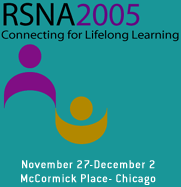
Abstract Archives of the RSNA, 2005
Bradford Wood MD, Abstract Co-Author: Nothing to Disclose
Sergio Dromi MD, Presenter: Nothing to Disclose
Victor Frenkel PhD, Abstract Co-Author: Nothing to Disclose
Julia Locklin MS, Abstract Co-Author: Nothing to Disclose
Steven K. Libutti MD, Abstract Co-Author: Nothing to Disclose
Peter Kanter PHD, Abstract Co-Author: Nothing to Disclose
Ziv Neeman MD, Abstract Co-Author: Nothing to Disclose
et al, Abstract Co-Author: Nothing to Disclose
To evaluate the feasibility of heat activated liposomal doxorubicin combined with RFA in animal, in vitro, and human models.
RFA was performed in dog liver during an IV infusion of 1mg/kg doxorubicin encapsulated in a heat-sensitive liposomal carrier (ThermoDox TM). The special liposome deploys its cargo at 39 to 42 degrees C. Dog liver tissue was assessed 30 days after RFA for histological changes. Dog groups included RFA alone, drug alone, and RFA plus heat-sensitive liposomal doxorubicin. Similar technique was used as we reported in swine at RSNA 2004 with RFA plus IV ThermoDox TM. Dog liver tissue was assayed for doxorubicin and metabolites as well as signs of acute histological damage. Fluorimetry studies of ThermoDox TM were performed to assess heat sensitivity and deployment dynamics. A phase 1 dose escalation study in humans combining RFA and ThermoDox TM has begun.
Heat activated drug delivery can markedly increase histological damage to target liver when combined with RFA in a predictable and manageable fashion. As expected, the most profound effect is seen at the margin of coagulation necrosis. Histological analysis showed more acute local damage to the target tissue in dog liver in ThermoDox TM + RFA compared with RFA alone. No liver or systemic toxicity was seen in the RFa plus ThermoDox TM group that was not seen in the RFa alone group. The coagulation necrosis lesions were larger in dogs treated with RFa plus ThermoDox TM, and there was more fibrin deposition. ThermoDox TM deployment dynamics were defined with fluorimetry.
RFA plus heat activated doxorubicin (ThermoDox TM) is safe in dogs and increases the size of the thermal lesion. Chemical, thermal, mechanical, and anatomic synergy may augment drug delivery when RFA is combined with heat sensitive liposomal carriers like ThermoDox TM . Liposomal carriers hold immense potential for drug or therapetic delivery and may turn local RFA into a more regional therapy. Dose escalation trials are underway and multicenter phase II/III trials are being organized.
P.K.: At RPCI; contracted by Celsion Corp to conduct Dog RFA StudyB.W.,S.K.L.: Have a collaboraive research and development agreement through NIH with Celsion Corp, who partly sponsored this study
Wood, B,
Dromi, S,
Frenkel, V,
Locklin, J,
Libutti, S,
Kanter, P,
Neeman, Z,
et al, ,
Heat-activated Drug Delivery with RFA: A Targeted Drug/Device Image-guided Therapy. Radiological Society of North America 2005 Scientific Assembly and Annual Meeting, November 27 - December 2, 2005 ,Chicago IL.
http://archive.rsna.org/2005/4419283.html

